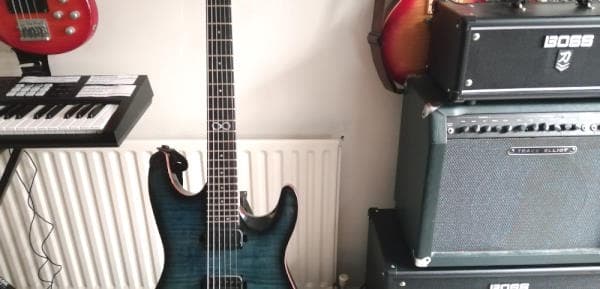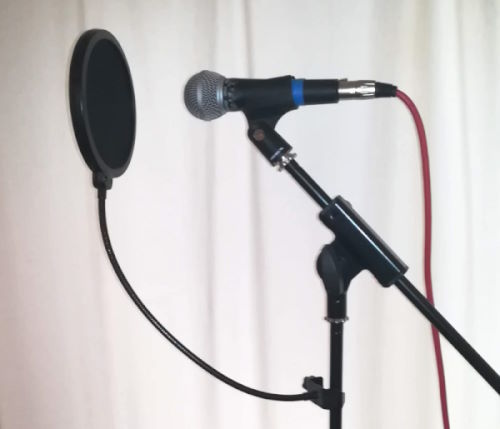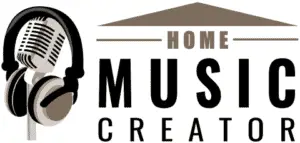In a home studio today, you can do what 30 years ago would have required a professional recording studio, and many hundreds of thousands of dollars worth of equipment. Yet pro recording studios still exist, and offer some benefits even with the technology widely available today for use at home. So realistically, do you need to go to a recording studio to make music?
You do not need to go to a professional recording studio to make music. Even commercial hit records can be created in a home studio, with the right skills and experience. Pro studios do still have benefits though, particularly the equipment they contain and the expertise of their specialist staff.
Some studio activities are easier to do than others at home. Recording electric guitars at home is very easy for example; for more information see my article on using software “amp sims” (guitar amplifier simulators). Recording a full drum set is much more difficult, and is probably best done in a pro recording studio for most people.
Read on to discover the pros and cons of home and professional recording studios, along with the capabilities of both.
This website is all about creating music in your own home. If you are a novice to home recording, you should definitely check out my “how to record music at home” beginners’ guide, written for people just like you! You’ll learn what you need to get started, what you can do in a home studio, and you’ll be walked through making your first recording.
If you are interested in checking out the best recording gear such as audio interfaces, studio monitor speakers, microphones, etc., you can find them at Amazon by clicking here.

Home studio vs pro studio summary
Here is a summary of the advantages of a professional studio compared to a home studio…
| Home recording studio | Professional recording studio |
|---|---|
| Cheap | Expensive |
| Have to learn to do everything yourself | Professional highly skilled expertise |
| Limited equipment available | High-end equipment available (e.g. microphones, guitar amps, etc) |
| Effectively unlimited time available | Time pressure – could be rushed |
| Improvised space shared with other uses | Specially designed spaces for optimal acoustics |
There is also the option of a “hybrid” approach, where some tasks are performed at home while others are taken into a studio. This article discusses these various tasks and approaches, and helps you decide the best way forward to make your music.
Some people are confused as to what a home recording studio actually is. It can vary hugely in size and complexity. That’s why I wrote my “what is a home recording studio” article. It looks at the different types of home studio, the equipment needed and what you can realistically do in each type of setup. It’s recommended reading if you are thinking of setting up a home recording studio.
What do you need to make music at home?
First, let’s lay out exactly what we are comparing to a pro recording studio when we are talking about making music at home.
You do not need a huge amount of money to buy the equipment necessary to make music at home. But what exactly do you need for such a home studio? These are the things you are likely to need…
- Computer running a DAW (Digital Audio Workstation software)
- Audio interface
- Decent studio headphones
- Mic/mic stand if you’re recording vocals
- Amp sim software for guitar/bass
- Drum software if you want to use programmed drums
- Cables (XLR, jack, etc.)
Assuming you already have a computer, there are free options for all the software you would need; DAWs, amp sims and drum software. You should be able to buy an audio interface, decent studio headphones, microphone, stands and cables for a few hundred dollars in total.
This collection of hardware and software should enable you to make whatever music you like at home. Recording, editing, mixing and mastering are all doable with this gear. Obviously, you will have to put the time in to learn how to do all this and to get the best out of the equipment. There are lots of free and paid training & courses available from the likes of YouTube; it is entirely feasible to teach yourself the skills you need. In exchange for the time you put in, you will develop skills you will be able to make use of for years in making your own music.
You might be viewing all this with a dose of skepticism, and be thinking surely you can’t get pro-level results from a home studio? If so, take a look at my “recording professionally at home” article. You’ll get lots of tips to get the very best results out of your home studio setup, and it should put your mind at ease.
For an initial outlay of just a few hundred dollars, you could have a home-based music-making setup that allows you to make your music from start to finish.
So why would anyone pay for a professional recording studio today?
Pro studios have invaluable skills and expertise
The most valuable commodity that professional studios have to offer in my opinion is the skills and expertise of the staff that works there. Unless you are highly skilled with decades of experience, they will have knowledge/experience you don’t. This can include…
- How to make any individual track recording sound the best it can
- Knowledge about how to use/get the best out of the equipment
- Coaching; ability to coax the best possible performance out of a musician
- Specialist recording knowledge e.g. how to record a full drum set
- Know how to get combinations of things sound good
Let me give you an example from my personal experience…
A few years ago I was recording in a professional recording studio. Working on a song I had written called “Calm Down”, the engineer suggested we add another guitar part. He then proceeded to get one of the most horrible, scratchy electric guitar sounds I had ever heard out of one of his tube amps. That was the sound he wanted us to record. We were dubious, but he urged us to trust him and we recorded the part using that sound anyway. And you know what? When that guitar sound was added in with the rest of the mix, it sounded great! It was exactly what the song needed.
This is the type of knowledge that takes years and years to build. That type of intuition based on extensive experience is impossible to replicate on your own at home, and can give that special little extra to your song that you just can’t otherwise get.
Pro recording studios contain high-end gear
Professional recording studios are likely to contain expensive high-end gear, that is likely to be financially out-of-reach of the typical home recording musician. Expensive condenser and ribbon microphones, vintage tube guitar amps, high-end synthesizers, etc. could all be available for you to use in your pro studio session.
Unless you are rich, this type of equipment is likely to be well out of your price range. These days there are affordable software emulations of many types of music gear that can be used at home, such as…
- Guitar amp sims like BIAS FX
- Sound modules like Sampletank
- Drum software like EZ Drummer & Superior Drummer
Many of these can be used to emulate the type of expensive gear found in a pro studio to good effect. It is a matter of opinion whether these give a result as good as using the real, physical thing. It is certainly possible to get very good results from software instruments and simulators – I have done many times.
But if you absolutely must have the real physical thing, buying studio time to get you access to that equipment could be a good way to go.
Physical benefits of a pro recording studio

Professional recording studios often contain one or more spaces specifically designed for the tasks that take place in them. For example…
- Acoustically treated recording (live) room
- Specialist rooms e.g. vocal booth, drum room etc.
- Control room acoustically optimized/treated for music listening/mixing
Contrast this to the physical space in your home where you perform your music-making activities. This may be a bedroom, a spare room, a corner of a dining room, or even just a laptop and an audio interface where you take wherever you can find a bit of space and quiet.
Obviously, the acoustic characteristics in a pro studio are almost always going to be superior. If you’re not recording using microphones then this is a moot point, as the room sound won’t make it onto your recordings anyway. But it can still affect mixing and editing if you are listening to your music on speakers. Unwanted sound wave reflections from walls and other surfaces can give a misleading picture of what your music actually sounds like.
You can compensate for this to an extent by using a good set of reference headphones instead of speakers. But the pro studio has the upper hand here.
In your home, some rooms will be better for recording than others. And the location inside the room can also make a big difference to the quality of your recordings. Check out my article on the best place to record at home for help in selecting and setting up the right location to give you the very best sound possible.
Red light fever can be worse in a recording studio
Red light fever is paralyzing nervousness or anxiety when you are trying to record a part. It is most often associated with vocalists, although it can affect instrumentalists as well. It makes you incapable of performing a part adequately when recording, even though usually you can perform it well.
The name red light fever comes from the red light that sometimes exists outside a studio’s recording room. This illuminates when recording is in progress to let people know that the recording shouldn’t be interrupted.
Being in a professional recording studio can make red light fever much worse. It is a fundamentally intimidating environment, forcing you to perform in unfamiliar surroundings and to strangers who may well be critical of you.
I certainly wouldn’t go into a recording studio if I had never recorded at home. You need to get yourself to a certain level of confidence before subjecting yourself to that environment for the first time. For tips on how to reducing anxiety and increasing confidence, see this website’s article on reducing red-light fever for vocalists.
Red-light fever also has a knock-on effect – it may make you take longer to record a part than it normally would. You might have to double the amount of takes you record to get a decent performance, for example.
This could mean the time taken will potentially significantly increase…
Recording studio time pressures
As you are paying by the hour in a recording studio, you are always going to be effectively on-the-clock. You may have booked a certain number of hours, and be rushed to complete recording in that time. This may lead to performances not quite as good as you know you are capable of, when you decide to settle for a sub-par take due to time constraints rather the record another one.
This can also lead to a feeling of anxiety due to the increased pressure. Some musicians actually thrive under that pressure, whereas others play best when they are relaxed. Regardless of which type you are, it is always worth being as prepared as you possibly can be before venturing into the recording studio. The more prepared you are, the less of an effect the time pressures are to have on you.
It’s always a challenge trying to estimate how long it will take to record a song. For some help, check out this article – “how long does it take to record a song?“. Obviously, the time taken will vary greatly from song to song. However, this article will give you a good general idea of the sort of times you can expect for different style, genres and recording approaches.
Assuming it fits into the studio’s schedule, you could always buy more time. But that can get very expensive very quickly…
How much does studio time cost?
Recording studio time typically costs from $100 to $500 per hour. This allows you access to all the high-end equipment the studio contains. At least one recording engineer will also usually be included in the price, whose expertise can be invaluable in getting the best sounding recording possible.
In your home studio, once you have made the initial outlay for your equipment you don’t need to spend any more money. But in a pro studio, it can get very expensive very quickly. I’m sure you don’t need me to do the math for you based on the above costs, to work out that even just one full day in a pro studio could be prohibitively expensive.
Recording studios are expensive because they have to pay for full-time, highly skilled specialist staff. They also have to pay for maintenance of their equipment, which has to be kept running at all times. Standard business costs such as rent, taxes, etc. also have to be paid.
Based on all the above considerations, only you can decide whether you consider the cost of going into a recording studio worth it.
Consider a hybrid approach using home and pro studios
With the advancement of technologies available to us at home, a hybrid approach to recording is becoming more and more common these days. This is where some music-making activities are done at home, with others that require more specialist equipment and/or knowledge performed in a pro recording studio.
The following are all examples of such a hybrid approach…
- Go to the studio just to record drums, with all other parts recorded at home
- Use studio purely for mixing (recording done at home)
- Make high-quality demos at home; iron out all the issues & get parts nailed down, then go into the studio with the aim of re-recording at the best quality possible very quickly
This can be a very effective way of reducing the cost, while taking advantage of the advantages of a professional studio for just the activities that could really benefit from it.
If you take the hybrid approach, you will almost certainly have to send your tracks to someone else to work with. In that case, definitely check out my article on consolidating your tracks. This is a vital process to perform on your tracks before you send them to someone else, especially if they are working in a different DAW to you.
Conclusion
So you can you make a complete commercial song entirely at home? Absolutely you can!
You may however, have to spend a fair amount of time training, practicing and building up your skills to get to the point where you are capable of that. Using a professional recording studio could eliminate a lot of that time, if you are prepared to pay for it.
The pro recording studio can also offer you things you just can’t get at home, such as the use of very high-end equipment, specially acoustically designed rooms and specialist expertise.
Ultimately it comes down to what you personally have available. If you have a lot of time and very little money, then the home studio route will suit you better. If you have little time but a lot of spare cash, buying studio time may be a better option for you.
Here is some of my favorite home studio gear…
Thanks for reading this article. I hope you found it helpful in your home music-making activities. Here are a few of the tools that I personally use in my home studio. These are affiliate links, so if you decide to use any of them I’ll earn a small commission.
Audio interface: My personal choice for audio interfaces are the Focusrite Scarlett series. I have been using these for years, and they have always given me great-sounding recordings. For a very reasonable price from Amazon you can buy the excellent Focusrite Scarlett 4i4, or if you don’t need MIDI capability the Focusrite Solo is a great choice.
Amp sim: Guitar amplifier simulator software has come on leaps and bounds in recent years, such that I record all my electric guitar parts using amp sims these days. One of the very best is the incredible Amplitube from IK Multimedia, which I have used on many of my songs.
Headphones for recording: My favorite headphones for recording are the Sony MDR-7506s, which I use for monitoring during all my recording sessions. They can also be found in many pro recording studios. Get the Sony MDR-7506 headphones from Amazon here.
General-purpose microphone: You can’t go wrong with a good ol’ Shure SM-57, one of the most versatile and ubiquitous microphones around. I’ve been using one in my home studio for as long as I can remember. Amazon offers the Shure SM-57 for a very competitive price.
To see all of my most up-to-date recommendations, check out this resource I made for you!


